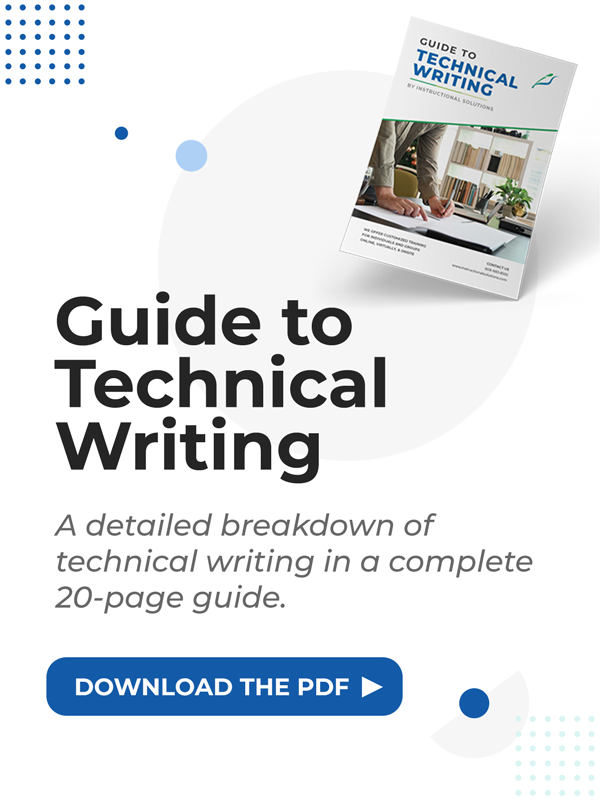How to Write Procedures: A Step-by-Step Guide to Improve

Originally published November 29, 2022, updated June 10, 2025

Table of Contents
A procedure is a detailed, step-by-step set of instructions that outlines how to perform specific tasks or processes. In any organization, procedures are the backbone of consistent and efficient operations. These documents serve as essential guides, ensuring that tasks are executed correctly and uniformly across the board.
Understanding how to write procedures effectively is crucial for professionals across many roles. Operations managers rely on them to maintain workflow consistency; HR professionals use them to streamline onboarding processes; IT specialists document technical protocols; compliance officers ensure regulatory adherence; and quality assurance teams uphold product and service standards. Even in fields like healthcare, finance, and manufacturing, well-crafted procedures are indispensable for safety and compliance.
This article will explain the fundamentals of writing clear and effective procedures, explain how to write them, provide examples, and highlight tips.
What is a procedure?
A procedure is a technical document that describes, step by step, what actions to take in specific instances.
Policies and procedures go hand-in-hand, but are not the same thing. Policies generally tell readers what to do and why it's done, while procedures tell people how to do it. Here are a few more facts about procedures:
- Continuously change and improve
- State what, how, when, or who.
- Offer a detailed description of activities.
Whether formal or informal procedures, these documents should be strictly followed to achieve the desired outcome. A procedure's cyclical nature and uniformity are vitally important for training new employees, compliance, process improvement, and auditing.
Common examples of procedural topics include emergency procedures, material ordering, equipment operation, how to inventory supplies and goods, how to take attendance each day, and how to assemble products.
One good example of an emergency procedure is a fire drill. The fire drill procedure states where each classroom should go in the case of a fire drill, noting specific routes and offering alternatives. As the drills are practiced, the procedure will likely change and improve.
Practice your technical procedure writing and get instructor feedback on your actual technical writing.
Learn More About the CourseWhy is procedural text writing important?
Clear procedures ensure that employees behave in specific ways, holding them accountable. Tasks are consistently carried out according to policy. They also help reduce errors and ensure compliance. New and experienced team members alike follow the same standards and detailed steps, allowing departments and businesses to achieve key objectives.
How to Write Procedures
Writing clear and effective procedures is a skill that supports consistency, safety, and productivity across all functions of an organization. Whether you’re documenting a technical process, outlining HR protocols, or standardizing quality assurance steps, a structured approach is essential.
This section provides a step-by-step guide on how to write procedures that are easy to understand, follow, and maintain.
1. Identify the Purpose and Audience
Start by defining why the procedure is needed and who will use it. A procedure for new employee onboarding in HR will look very different from one outlining safety checks on a factory floor. Knowing your audience helps tailor the language, tone, and level of detail.
Example:
An IT procedure for configuring network printers should assume some technical knowledge, while a customer service call script should be simple, direct, and jargon-free.
2. Gather Input from Subject Matter Experts
Involve team members who perform the task. They can provide insights that may be missing from policy-level documentation and help identify variations or bottlenecks.
Example:
A warehouse manager and line staff may provide key steps for inventory checks that aren’t covered in standard operating guidelines.
3. Break Down the Process into Clear Steps
List each step in a logical sequence. Use numbered lists to reinforce the order and action verbs to clarify what must be done. Each step should focus on a single action.
Example:
Instead of:
"Scan, label, and shelve items."
Write:
- Scan the item barcode using the handheld scanner.
- Print and attach the product label.
- Place the item on the designated shelf by category.
4. Use Consistent Formatting and Language
Procedures should be easy to scan. Use headings, bullets, and bold text for important notes. Stick to plain language and avoid acronyms unless they are clearly defined.
Example:
Use "Turn off the power switch" instead of "Deactivate the system via the secondary control module."
5. Include Visuals Where Appropriate
Diagrams, screenshots, and flowcharts help clarify complex steps and reduce confusion. They are especially helpful in technical or hands-on environments.
Example:
In a medical lab procedure, include an annotated image of the equipment with key buttons labeled.
6. Review for Accuracy and Test the Procedure
Ask someone unfamiliar with the task to follow the procedure exactly as written. Gaps or unclear steps will quickly become apparent. Revise based on their feedback.
Example:
In a finance department, a new hire testing an expense reporting procedure may uncover missing details about required receipt formats.
7. Update and Maintain the Procedure
Procedures are living documents. Set a review schedule and ensure updates are made when systems, policies, or tools change. Note the last revision date clearly at the top.
Example:
A software update might require changes to an internal procedure for generating client reports.
Key Tips to Improve Your Procedure Writing
Below is a list of steps to follow when writing a procedure.
1. Follow a structured writing process
Never jump straight into drafting with procedure writing. You'll end up spending more time editing in the end. Instead, start by planning.
First, analyze your audience. Determine who your reader(s) is. Also, think about the purpose of the document. Why are you writing the procedure? What do you want the reader to know or do?
Next, generate content ideas. Maybe you already know what complex steps and detailed instructions need to be included. Write them down. Or perhaps you need to do more research. Interview team members to determine necessary tasks or basic steps.
Organize all of this info into an outline or concept map (an excellent visual way to organize complex ideas). Categorize and sequence the information. Place "like content with like content." Also, create headings that briefly summarize the contents of each section.
Ensure that the sequence of ideas makes logical sense for the reader. Here's an example of how your procedure sequence might look
- Title page
- Publication/revision date
- Introduction/purpose
- Definitions
- Step-by-step instructions
Only after all this planning is in place should you start drafting. Drafting should actually be the easy, creative part here -- you've already completed the challenging, analytical part! Edit as a final step.
Note: Maybe you have a template you can use for your procedures. Templates are great time savers, but remember that your writing process should always precede template use. Let the process guide the template.
2. Get team input to improve procedure writing
Connect with team members who can help guide the steps in your procedure. Choose internal experts. For example, if you're writing a restaurant's Standard Operating Procedure, you might ask for input from
- Head chef
- Customer host or hostess
- Server
Next, send an email requesting feedback or set up a formal call or meeting. Show the team the outline or concept map you created (MindMeister can be a great concept mapping tool because it allows for collaboration). Ask for feedback on the steps you've outlined and if you've covered all necessary tasks (involving team members also provides a sense of ownership with the document). Also, make a list of any necessary resources and tools to include in the procedure doc.
3. Choose a format
Decide the best format for your document and how you will present the info. For example, you might choose a checklist or a hierarchical steps format with detailed instructions. Make sure whatever format you choose matches your organization's branding guidelines and preferences. It can help to review current procedures.
Also, consider where the information will live. Will your procedure doc be a PDF in a resource library? Or as a webpage on your organization's internal site? You might choose to format it in a Google Doc so the information can be easily updated and transferred to the proper location.
However, you decide to present the info, format the document to make it easy for your reader to absorb and scan. Here are a few tips for formatting effective procedures:
- Incorporate adequate white space
- Use shorter paragraphs — no longer than seven lines
- Add headings — the natural antidote to information overload
- Judiciously use bold, italics, and colored text
- Ensure graphics are formatted correctly, don't need extra explanation, and aren't redundant
Graphics and tables are powerful tools in procedure writing. However, a poorly used graphic will confuse readers and hinder your message. Make sure any graphics, tables, or text are easy to read (e.g., no blurry pictures). They should also integrate with the narrative.
A good rule of thumb is also to avoid irrelevant decoration.
A decoration is defined as a graphic that seems to have a vague relationship to the subject of the given article but is content-free – it adds absolutely nothing to the reader’s understanding of the subject at hand. For example, in an article discussing the job description of a software developer, an illustration taken from a free image website would be considered a decoration.
4. Ensure that what you write aligns with policies
As you're planning your procedural doc, make 100% sure that all procedural documents align with organizational policies. When you find it difficult to draft clear and well-written procedures because they conflict with existing policies, that's likely a sign you need to revisit the policies.
5. Edit, edit, edit
With your draft in place, start by editing the substance or content of the procedure. Ask yourself: Will the steps make sense for the reader? Is more context needed? Is everything categorized and sequenced logically?
If the substance checks out, edit your procedure doc on a sentence level. Here are a few ways to hone the clarity of your document:
- Use active voice over passive
- Eliminate any jargon
- Use short words to enhance clarity
- Write in a neutral tone
- Avoid gendered and insensitive language
Also, edit for grammar. We always recommend using a grammar check, such as Grammarly. This tool helps make sure that you don't have any careless errors, especially in important documents. Enhance understanding and ensure you're not losing any points for professionalism.
6. Test the procedure (revise if needed)
Testing the procedure is vital to ensure you haven't missed anything. Allow team members to follow the procedure and ask for feedback. Identify any problems, such as missing steps, and revise procedures if needed. Deploy when you're certain that all steps are clear.
Also, remember that a procedure is a living document. Keep your procedure document up to date by reviewing and potentially revising it at least once per year (ensure that it still meets the policy requirements).
Procedure Writing Examples
1. Restaurant SOP
Standard operating procedures (SOPs) encompass the various procedures required for a well-run organization. SOPs compile all of the necessary individual procedures that are necessary for smooth operation.
Restaurant standard operating procedures (SOPs) are written lists of rules, standards, and norms describing how to complete routine tasks. They help streamline operational and managerial processes at a restaurant. These procedures could include everything from hygienic food preparation to restaurant maintenance, billing, making payments easy for customers, and so on.
Here's a snapshot of a restaurant's SOP section:
Food Preparation And Handling:
a) Standard Recipes and Food Preparation Methods
This section of a restaurant's SOP would contain the basic guidelines and protocol to prevent your customers from getting a food-borne disease or any other illness due to spoilt food. The preparation protocol indicates the rules for particular dishes as well. Let’s take soup, for example. Some restaurants have a strict policy of cooling a soup to around 135 degrees F before serving it.
This section would also specify guidelines for different employees who handle food. The SOPs for a bartender will vary from those for the head chef.
b) Food Presentation
The service standards of casual dining, a retro bar, and a fine dining restaurant will all be different. A restaurant needs to be able to define these standards to work the most efficiently. A restaurant SOP should contain all the how-to’s and why’s of the first-line staff of the restaurant.
c) Food Storage
A restaurant needs to be able to store its food and maintain a proper inventory. This would require adequate training for your staff to minimize wastage. A detailed set of instructions would help with how a restaurant wants to store its food. Add the minute details about the quality and quantity of the food that you save.
Other restaurant SOP sections could include customer service standards (e.g., customer complaint management) and equipment handling, such as health and hygiene regulations and safety. A standard procedure like this one helps make it easy to replicate the process in the same way, every time.
2. Operation SOP
The following SOP is for the Central Fire Protection District of Santa Cruz Counties' personnel operating vehicles. The four-page doc outlines how to properly use these vehicles to enforce safety laws and the safety of the drivers.
Key sections include:
a) Title
The SOP's title is "Seat Belt Usage." We'd recommend including a more descriptive, specific title (e.g., Required Seat Belt Usage for Personnel Operating Vehicles).
b) Scope
The SOP includes a brief overview of who the document applies to at the top, so the reader knows what to expect before reading.
c) Purpose
This section summarizes why the document was written and why following proper seat belt usage is important, including persuasive facts about vehicle collisions and deaths.
d) Definitions
All definitions related to seat belt usage are included. One example is the Law and Statutes enforcing the use of seat belts, such as the California Vehicle Code Section 27315.
e) Responsibilities
Readers can review this section to know who is responsible for proper seat belt usage. Those responsible include the Shift Battalion Chief, Driver, Officer, and Members.
f) Procedures
Detailed steps about seat belt usage are presented to ensure that there are no gray areas about when a seat belt should be used. For example: "No person shall operate a District vehicle in which the seat belt in the driver's position is inoperable."
Note: The information in this SOP could also get confusing and dense, but the writer incorporated clear headings and white space through the use of bulleted lists and paragraphs to create digestible content.
Continually polish your procedure writing
Procedure writing is 50% planning. Make sure you complete the analytical work first (i.e., analyze your audience, generate content, categorize and sequence info) before you start writing. Also, involve the team in the creation of the document. This will ensure a clear, understandable document with detailed instructions that help operations run smoothly.
Need more help as a procedure writer? Consider enrolling in Instructional Solutions' online Technical Writing Course. In addition to writing excellent procedures, you'll learn how to write technical reports and more! You'll also receive constructive feedback from our expert team of instructors on technical writing assignments. Access online resources, videos, and quizzes to enhance your understanding of concepts. Learn more here.
Conclusion
Knowing how to write procedures effectively is a critical skill for ensuring consistency, safety, and efficiency across your organization. Clear procedures bridge the gap between policy and action, helping teams follow best practices, reduce errors, and meet compliance requirements. Whether you're in operations, HR, IT, quality assurance, or any other field, strong procedure writing strengthens team performance and supports organizational goals.
By following a structured, step-by-step approach—from identifying the audience to testing and maintaining the document—you can create procedures that are not only clear and actionable but also valuable tools for onboarding, audits, and daily operations.
Investing the time to learn and apply best practices in procedure writing pays off in fewer mistakes, smoother workflows, and more confident teams. Mastering how to write procedures isn't just about documentation—it's about enabling success at every level of your organization.
Want to strengthen your team’s procedure writing skills?
Explore our Foundations of Technical Writing course to gain practical, expert-led training. Equip your team with the tools to write procedures that are clear, effective, and ready for real-world application.
Become a stronger technical report writer and advance your career.
Enroll in our online, self-paced technical writing foundation course and get detailed feedback on your actual writing.
Frequently Asked Questions
What is the first step in writing a procedure?
The first step in writing a procedure is to clearly define its purpose and identify the target audience. Understanding why the procedure is needed—and who will use it—helps determine the appropriate tone, level of detail, and structure. This foundational step ensures the procedure will be relevant, effective, and user-friendly from the start.
What’s the best format for writing procedures?
The best format for writing procedures is a clear, step-by-step structure using numbered lists for sequential actions, supported by headings, bullet points, and visuals where appropriate. Each step should begin with an action verb and describe one task at a time. Use consistent formatting, plain language, and highlight important notes or warnings. A well-formatted procedure typically includes:
- Title and purpose
- Scope and audience
- Required materials or prerequisites
- Step-by-step instructions
- Visual aids (diagrams, screenshots)
- Revision date and version history
This format makes procedures easy to follow, reduces confusion, and ensures consistent execution across teams.
What are some common mistakes to avoid when writing procedures?
Several common mistakes can reduce the clarity and effectiveness of procedures:
- Using vague language – Avoid general terms like “handle appropriately” or “do as needed.” Be specific and action-oriented.
- Skipping steps – Even seemingly obvious steps should be included to ensure consistency, especially for new team members.
- Failing to define the audience – Procedures must match the reader’s knowledge level and fulfill the purpose of the procedure. Overly technical or overly simplistic instructions can confuse.
- Writing long, dense paragraphs – Procedures should use numbered steps, headings, and white space for easy scanning.
- Omitting visuals – When applicable, diagrams, photos, or screenshots can clarify complex steps.
- Neglecting to review or test – Unverified procedures may include errors or gaps. Always test for accuracy and usability before finalizing.
- Failing to update regularly – Outdated procedures can lead to mistakes or noncompliance. Include a revision date and review schedule.
Avoiding these pitfalls will help ensure your procedures are clear, useful, and consistently followed.
How do I make my procedures easy to follow?
To make your procedures easy to follow, focus on clarity, structure, and user-centered design:
- Use clear, simple language – Avoid jargon or technical terms unless they’re well understood by your audience.
- Break tasks into step-by-step instructions – Number each step and ensure each one describes a single, specific action.
- Start each step with a strong action verb – This keeps instructions direct and consistent.
- Use consistent formatting – Headings, bullet points, bold text for key terms, and adequate white space make procedures easier to scan.
- Include visuals when helpful – Diagrams, flowcharts, and screenshots can clarify complex steps.
- Test the procedure – Have someone unfamiliar with the process follow your instructions. Their feedback will highlight areas that need clarification.
- Write for your audience – Tailor tone and detail to the reader’s role, background, and knowledge level.
Well-structured, user-focused procedures reduce confusion, improve accuracy, and boost confidence in task execution.
What should be included in a procedure document?
A well-structured procedure document should include the following key components:
- Title – Clearly state the procedure’s name.
- Purpose – Explain why the procedure exists and what it aims to accomplish.
- Scope – Define where and when the procedure applies, and who it applies to.
- Responsibilities – Specify who is responsible for performing the procedure.
- Materials or prerequisites – List any tools, documents, or information needed before starting.
- Step-by-step instructions – Use numbered steps to outline the exact actions required. Begin each step with an action verb and keep the language clear and specific.
- Visual aids (if applicable) – Include diagrams, flowcharts, or screenshots to enhance clarity.
- Safety or compliance notes – Highlight any critical warnings, regulations, or quality standards.
- Revision history – Track version numbers, dates, and updates to ensure the procedure remains current.
Including these elements ensures your procedure is clear, complete, and easy for users to follow and apply correctly.
How do I ensure my procedures are effective?
To ensure your procedures are effective, focus on clarity, usability, and continuous improvement:
- Define a clear purpose and audience – Tailor the language and level of detail to the people who will use the procedure.
- Write with precision and structure – Use clear, step-by-step instructions with action verbs, numbered lists, and consistent formatting.
- Test the procedure – Have someone unfamiliar with the process follow the steps exactly. Their feedback will reveal gaps, confusion, or ambiguities.
- Include visuals where helpful – Diagrams, flowcharts, and screenshots can enhance understanding and reduce errors.
- Get feedback from users – Regularly ask the people performing the task for input to improve clarity and accuracy.
- Keep it updated – Review procedures periodically and revise them as systems, tools, or regulations change.
Effective procedures are not just well-written—they’re practical, actionable, and consistently used as reliable tools in day-to-day operations.
How often should procedures be updated?
Procedures should be reviewed and updated at least annually, or whenever a significant change occurs, such as updates to technology, regulations, policies, workflows, or organizational structure.
High-risk or frequently used procedures may require more frequent reviews (e.g., quarterly). Each procedure should include a revision date and a designated review schedule to ensure it remains accurate, compliant, and relevant.Regular updates help prevent errors, maintain consistency, and support ongoing improvement.


